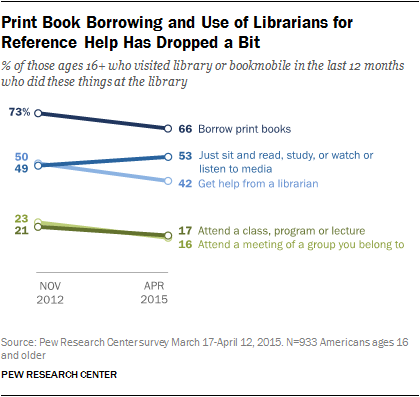With today’s technology, it might be easy to assume that community-building is a seamless process. In the latest lecture by @michael, he started off by using Peter Block’s definition of communities, which were described as “human systems given form by conversations that build relatedness (Block, 2008). Yes, technology can facilitate connection, but it doesn’t guarantee it. Even with the proliferation of algorithms ruling our decisions online, studies have shown an increasing desire for human-curated recommendations (Bhaskar, 2016). The human touch goes hand-in-hand with emerging technologies and is something libraries should keep in mind during outreach.
Community engagement doesn’t always have to mean working harder—it’s about working smarter. There’s already a misconception that libraries are merely for books, so simply handing out surveys regarding library services won’t lead to any revealing answers; libraries have to engage with more personal questions, which will illuminate the interests of the community and in turn supply them with services that anticipate those needs and wants (Schmidt, 2016). Navigating community needs versus what the library wants is a tricky balance. While we have a significant number of adults using our computers and checking out our books at my library, I’ve noticed that they aren’t as likely to check out the adult programs. It’s a striking difference compared to children’s programming.

How do we create programming that will actually get people to show up? Our staff gets a lot of questions regarding technology use, which sometimes can be time-consuming on busy days. Perhaps getting that deeper connection with local communities doesn’t have to be anything complicated. Plenty of children’s programming involves simple activities such as read-alongs. Teaching practical skills might be a way to jumpstart community engagement. It may be something someone can easily Google, but attending a library workshop is a great way to foster connection while learning.
References:
Bhaskar, M. (2016, September 30). In the age of the algorithm, the human gatekeeper is back. The Guardian. https://www.theguardian.com/technology/2016/sep/30/age-of-algorithm-human-gatekeeper
Block, P. (2008). Community: The structure of belonging. San Francisco, CA: Berrett-Koehler Publishers.
Schmidt, A. (2016, May 1). Asking the right questions. Library Journal, 141(8), 22. https://link-gale-com.libaccess.sjlibrary.org/apps/doc/A450998802/AONE?u=csusj&sid=bookmark-AONE&xid=b7dabb9d
3 responses to “Reflection Blogging #1: Getting To Know Our Local Communities”
I really enjoyed reading your post and you have some really thought-provoking ideas. I have also thought about this a lot – how the children’s programs get packed while the adult programs usually do not have many in attendance. I think this is in large part due to the library needing to reach out more, online and in person – making these services more well-known. This also coincides with the recent post by Professor Stephens, about the library that expanded their hours to reach more patrons. It is possible that many adult patrons simply do not have the time to make the programming during the library’s set hours due to work, school, and children. Maybe this could be combatted by bringing a mobile library to certain areas where these programs would actually be used?
Thank you for your response! Yes, that would be a great idea. A mobile library would help with outreach, especially outside of typical library hours!
This:
“Community engagement doesn’t always have to mean working harder—it’s about working smarter. ”
Is 100%! With that idea in mind and an eye on asking the right questions, I would argue that libraries might find the perfect mix for programming and service to meet the needs and wants of the community.